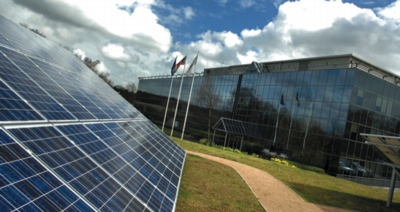Re-inventing how to do business

Bringing the UK’s existing building stock up to the standards needed to help achieve the Government’s long-term carbon-reduction target requires a different approach to market, which Mitsubishi Electric continues to build with the latest stage in its Green Gateway initiative.
Should the Government’s target of an 80% reduction in carbon emissions by 2050, based on 1990 levels, be regarded as a challenge, a threat to existing businesses or an opportunity. In arguing the case for the last of these options, Martin Fahey, Mitsubishi Electric’s sustainable-solutions manager, points out that the Government’s chief construction adviser, Paul Morrell, sees opportunities for a 40-year business plan for the construction industry — for the taking.
But well before Paul Morrell’s appointment just under two years ago, Mitsubishi Electric was already focusing on the need for reducing energy consumption and the opportunities to do so with the launch of its Green Gateway initiative and substantial associated publication presenting the company’s philosophy. One notable and controversial view was that air conditioning in homes is not necessary and, indeed, is a burden to the long-term objective of reducing carbon emissions associated with buildings. The Green Gateway initiative was presented to MPs in the House of Commons, including the-then chairman of the cross-party climate change group Colin Challen.
In the four years or so since the launch of Green Gateway early in 2007, the company has been building on the thinking and logic it presented and has now launched the second phase.
The focus of the second phase of the Green Gateway initiative is firmly on reducing carbon emissions from existing buildings. However, it is so much about technologies for reducing carbon emissions from existing buildings but the business approach, encapsulated on the front cover of the document as: ‘The way we do business.’
As Martin Fahey explains, ‘Each time we build or refit a building, we potentially fix its energy footprint for the next 10 to 20 years. We are fixing a large part of the future UK energy use every year in the construction industry.’
He then addresses the question of how to make the change.
The first suggestion is waiting for Government to pass legislation for the industry to comply with and/or to wait for incentives.
Mitsubishi Electric’s view on incentives is that they are not the best way to stimulate carbon-reduction measures. As Martin Fahey says, ‘Incentives will not be there for ever, not should they be there for ever.’
In contrast to waiting for legislation and incentives, he advocates standing up and being counted by showing leadership and building alliances.
‘No single person has all the answers,’ says Martin Fahey. ‘We need to work together to develop effective solutions. As a manufacturer we now find ourselves talking to corporate clients rather than just to contractors as we used to.’
One such client is Marks & Spencer to find how, as a supplier, Mitsubishi Electric can help achieve corporate aims relating to energy use. Alan Chisholm, engineering manager for property and store development with M&S comments, ‘Environmental concerns are increasingly critical to our business decision-making, and it’s great to work with a supplier that thinks the way we do.’
So what is preventing companies in the in the industry ‘standing up and being counted’?
Martin Fahey’s response is that many businesses think making the change will hurt them for reasons such as the extra cost of investment making them more expensive and that other companies will be cheaper. There is also the suggestion that ‘that’s not the way we do it’ — to which he responds, ‘We might have to do it another way.’
And to the reaction ‘there is no profit in doing the right thing’, he refers to his company’s experience that doing the right thing is a real differentiator in our market place.
Martin Fahey believes that interesting times lie ahead of us: ‘During the next 10 years we will see more rapid change than at any time in the history of the construction industry. Technologies considered new now will become mainstream.’ What might come as a surprise, however, is his view, ‘There is no lack of skills, only lack of knowledge and ambition.’
Green Gateway is Mitsubishi Electric’s preparation for the challenges ahead. But it does not apply just to Mitsubishi, rather is about changing behaviour through debate and increasing understanding of the crucial issues we face. That ultimate objective is guided by five key principles to direct the way business is done.
The first is doing the right thing. The background is the emission-reduction targets the Government has set for the UK, complemented by customers that increasingly want to address environmental issues. Green Gateway therefore supports the creation of a built environment that can help meet these drivers.
Next comes increasing efficiency to achieve major and lasting reductions in energy costs and emissions. Mitsubishi’s belief is that the priorities affecting how equipment is selected, installed, maintained and controlled need to change. A whole-life cycle view needs to be taken to avoid long-term energy efficiency being sacrificed to initial capital cost.
Having addressed energy consumption, then comes the need to further reduce carbon emissions by switching away from burning fossil fuels on site. A future where electricity is the only end-use energy is desirable and possible — but requires the grid to be decarbonised.
The third Green Gateway principle is to promote renewable energy on site to provide some independence from the grid supply and reduce reliance on fossil fuel to aid fuel security. Users of renewable energy tend to more aware of their consumption and more pro-active in reducing it. Mass-market solutions exist, and many UK buildings are well suited to the installation of renewable-energy systems.

And finally, the way we do business. This is about ensuring the right solutions are selected, taking the entire lifecycle into account — which requires more collaboration and diversification by all involved in the industry.
The way Mitsubishi, for example, does business, has been changed to ensure that engagement with all those required to deliver truly sustainable business is at the centre of all the company’s activity.
No one person or organisation has all the answers, so the working parties will need to share and exchange their expert knowledge. The view is that the best solution will always be an integrated solution.
What a company like Mitsubishi can contribute to the discussion is an intimate knowledge of its technologies and the solutions to which they can be put.
Collaboration at a corporate level enables that know-how to be passed on and for Mitsubishi to learn the issues facing the ultimate users of its solutions so that they can work better together. Developing new solutions and ways of doing business in response to current and future challenges is another objective of such collaboration.
The launch of the latest Green Gateway initiative coincided with World Green Building Week, which was promoted by the UK Green Building Council. Paul King, chief executive of UKGBC commented at the launch, ‘The debate that Mitsubishi Electric is trying to start is exactly what the week is all about. We need everyone to get involved — from individual architects, plumbing installers, homeowners and landlords, through to major corporations and businesses. Everyone should be questioning the amount of energy they use, and looking for ways to reduce it.’
Mitsubishi has developed a web site with much more information on it.
Proving what refurbishment can achieve
A noteworthy example of the benefits of refurbishing a building and updating its services is Mitsubishi Electric’s own headquarters at Hatfield.
It was originally built in 1986 with a chiller for cooling, gas-fired boilers for space heating and generating domestic hot water and a central air-handling unit.
Martin Fahey say, ‘We have made what we consider to be reasonable changes.’
Those changes include the application of heat pumps for heating and cooling — both air and ground source. These heat pumps have replaced the chiller and gas-fired plant.
Heat is recovered for use in other areas, an example being heat recovered from the canteen to meet the kitchen’s requirement for domestic hot water. The company’s PWFY water-heating system replaced a gas boiler and reduced running costs for producing hot water by 78%.
Renewable energy is represented by 8.5 kW of solar PV.
Following the implementation of these measures, the building received an Energy Performance Certificate with a C rating of 67. For comparison, a similar new building would be expected to have a rating of 62, and 117 (E) is typical of existing stock. Martin Fahey comments, ‘We applied solutions that sit in distributors’ warehouses in the UK — albeit with a bit of skill.’
And there is further to go in achieving a B — or, even, an A-rated EPC. Possibilities include increasing the amount of solar PV to 45 kW and replacing the central air-handling unit with heat-pump heating.
Martin Fahey concludes, ‘We know the challenges ahead of us. The solutions do exist, as do the skills.’









